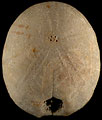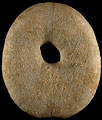The Echinoid Directory
Rhopostoma Cooke, 1959, p. 26
| Diagnostic Features |
|
|---|---|
| Distribution | Palaeocene (Middle Danian-Late Thanetian) of Denmark, Belgium, The Netherlands, Trinidad and the United States. |
| Name gender | neuter |
| Type | Anachytes cruciferum Morton, 1830, p. 245; by monotypy. |
| Species Included |
|
| Classification and/or Status |
|
| Remarks |
|





